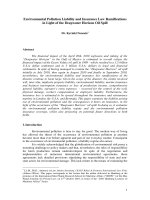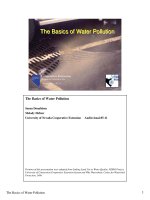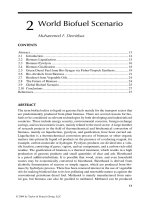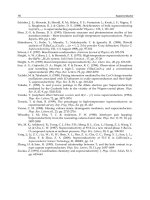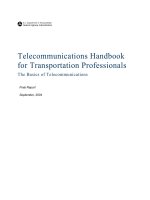The Basics of Oil Spill Cleanup - Chapter 2 docx
Bạn đang xem bản rút gọn của tài liệu. Xem và tải ngay bản đầy đủ của tài liệu tại đây (675.04 KB, 12 trang )
©2000 by CRC Press LLC
CHAPTER
2
Response to Oil Spills
Oil spills will continue to happen as long as society depends on petroleum and
its products. This is due to the potential for human error and equipment failure
inherent in producing, transporting, and storing petroleum. While it is important to
focus on ways to prevent oil spills, methods for controlling them and cleaning them
up must also be developed. An integrated system of contingency plans and response
options can speed up and improve response to an oil spill and significantly reduce
the environmental impact and severity of the spill.
The purpose of contingency plans is to coordinate all aspects of the response to
an oil spill. This includes stopping the flow of oil, containing the oil, and cleaning
it up. The area covered by contingency plans could range from a single bulk oil
terminal to an entire section of coastline. Oil spills, like forest fires and other
environmental emergencies, are not predictable and can occur anytime and during
any weather. Therefore, the key to effective response to an oil spill is to be prepared
for the unexpected and to plan spill countermeasures that can be applied in the worst
possible conditions.
This chapter deals with planning response to an oil spill and the functions of oil
spill response organizations in industry and government. Topics covered include
contingency planning for oil spills, which encompasses the activation of such plans,
the structure of response organizations, training, and supporting studies and sensi-
tivity mapping; communications systems; oil spill cooperatives; the role of private
and government response organizations; and cost recovery.
Studies of several major oil spills in the early 1970s showed that response to
these spills suffered not only from a lack of equipment and specialized techniques,
but also from a lack of organization and expertise to deal with such emergencies.
Since then, contingency plans have evolved and today often cover wide areas and
pool national and even international resources and expertise.
It is now recognized that oil spills vary in size and impact and require different
levels of response. Contingency plans can be developed for a particular facility, such
as a bulk storage terminal, which would include organizations and resources from
the immediate area, with escalating plans for spills of greater impact. Contingency
©2000 by CRC Press LLC
plans for provinces, states, or even the entire country usually focus more on roles
and responsibilities and providing the basis for cooperation among the appropriate
response organizations rather than on specific response actions. Some elements that
may be included in contingency plans today are listed in Table 2. Most contingency
plans usually include:
• a list of persons and agencies to be notified immediately after a spill occurs
• an organization chart of response personnel and a list of their responsibilities, as
well as a list of actions to be taken by them in the first few hours after the incident
• area-specific action plans
• a communications network to ensure response efforts are coordinated among the
response team
• protection priorities for the affected areas
• operational procedures for controlling and cleaning up the spill
• reference material such as sensitivity maps and other technical data about the area
• procedures for informing the public and keeping records
• an inventory or database of the type and location of available equipment, supplies,
and other resources
• scenarios for typical spills and decision trees for certain types of response actions
such as using chemical treating agents or
in-situ
burning
To remain effective, response options detailed in contingency plans must be tested
frequently. This testing is conducted by responding to a practice spill as though it were
real. This varies from a “tabletop” exercise to large-scale field exercises in which
equipment is deployed and oil is actually “spilled” and recovered. Such exercises not
only maintain and increase the skills of the response personnel, but also lead to
improvements and fine tuning of the plan as weaknesses and gaps are identified.
Photo 11
Incidents can occur in bad weather, a fact that should be considered in contingency
planning. (Environment Canada)
©2000 by CRC Press LLC
Activation of Contingency Plans
The response actions defined in contingency plans, whether for spills at a single
industrial facility or in an entire region, are separated into the following phases:
alerting and reporting; evaluation and mobilization; containment and recovery; dis-
Table 2 Contents of Typical Contingency
Plans
First Response
First Actions
Contacts
Procedures
Levels of Response
Actions for various levels
Organization
Responsibilities
Reporting
Systems
Procedures
Protection Priorities
Critical areas
Sensitive areas
Operations
Individuals and roles
Surveillance, monitoring and reconnaissance
Equipment deployment
Communications
Record-keeping
Public relations
Shoreline surveillance
Activation
Activation procedures
Action Plans
Deployment areas
Shoreline assessment and countermeasures
Disposal options
Scenarios
Decision trees
Scenarios
Exercises
Exercise procedures
Databases
Maps
Contacts
Equipment
Lists
Vendors
Supplies
Sensitivity Data
Extra resources
Science/Technology
Resources
Duties
©2000 by CRC Press LLC
posal; and remediation or restoration. In practice, these phases often overlap rather
than following each other consecutively.
Most contingency plans also allow for a “tiered response,” which means that
response steps and plans escalate as the incident becomes more serious. As the
seriousness of an incident is often not known in the initial phases, one of the first
priorities is to determine the magnitude of the spill and its potential impact.
Alerting the first response personnel and the responsible government agency is the
first step in activating an oil spill contingency plan. Reporting a spill to the designated
agency, regardless of the size or seriousness of the spill, is a legal requirement in most
jurisdictions in Canada, the United States, and in other countries.
The first response personnel assess the situation and initiate actions to control,
contain, or minimize the environmental damage as soon as possible. Until the full
command structure is in place and operating, employees carry out their responsibil-
ities according to the contingency plan and their training. This emphasizes the need
for a detailed contingency plan for this phase of the operation and the importance
of a high level of training in first response.
Stopping the flow of oil is a priority in the first phase of the operation, although
response may need to be immediate and undertaken in parallel with stopping the
flow. In the case of a marine accident such as a ship grounding, stopping the flow
of oil may not be possible, but the spillage can be minimized by pumping oil in the
ruptured tanks into other tanks or by pumping oil from leaking tankers into other
tankers or barges. These operations may take up to a week to complete and are often
Photo 12
Some response equipment used during the
Exxon Valdez
spill is shown here.
Much more equipment was in use at the time this photo was taken, indicating the
massive scale of response required for such an incident. (Foss Environmental)
©2000 by CRC Press LLC
delayed by bad weather. Once the flow of oil has been stopped, emphasis switches
to containing the oil or diverting it from sensitive areas.
Because oil spills pose many dangers, safety is a major concern during the early
phases of the response action. First, the physical conditions at the site may not be
well known. Second, many petroleum products are flammable or contain volatile
and flammable compounds, creating a serious explosion and fire hazard in the early
phases of the spill. Third, spills may occur during bad weather or darkness, which
increases the danger to personnel.
As more of the individuals called appear on the scene and begin to take up their
duties, the response plan falls into place. Response strategies vary from incident to
incident and in different circumstances and take varying amounts of time to carry
out. Response to a small spill may be fully operational within hours, whereas for a
larger spill, response elements such as shoreline assessment after cleanup may not
take place until weeks after the incident.
Training
A high calibre training program is vital for a good oil spill response program.
Response personnel at all levels require training in specific operations and in using
equipment for containing and cleaning up spills. To minimize injury during response,
general safety training is also crucial. In the United States, response personnel are
required to have 40 hours of safety training before they can perform field work.
Photo 13
Response equipment is stockpiled in a warehouse operated by a cooperative.
(Environment Canada)
©2000 by CRC Press LLC
Ongoing training and refresher courses are also essential to maintain and upgrade
skills. Training techniques for spill response include tools such as audiovisuals and
computer simulation programs that make the training more realistic and effective.
Structure of Response Organization
Most contingency plans define the structure of the response organization so that
roles and command sequences are fully understood before any incident occurs. The
On-Scene Commander (OSC) is the head of the response effort and should be
experienced in oil spill response operations. The OSC is responsible for making all
major decisions on actions taken. This person ensures that the various aspects of the
operation are coordinated and sequenced and that a good communications system
is in place.
The OSC is supported by a fully trained staff or response team whose duties are
clearly defined in the contingency plans. One or more individuals are often desig-
nated as Deputy On-Scene Commanders to ensure that there is backup for the OCS
and that multiple shifts can be run.
The structure of a typical spill response organization is shown in Figure 4. A
popular command structure today is a system called the Incident Command System
or ICS. This is similar to the organization shown in Figure 4, but involves common
elements to ensure uniformity across organizations and to make it easier for federal
responders to deal with contingency plans in areas other than their own familiar
territories. The Unified Command System, or UCS, is similar to ICS, but involves
the joining of the company, state, or province, and federal response structures. The
Photo 14
Equipment can be deployed very rapidly when it is already loaded on a truck.
(Environment Canada)
©2000 by CRC Press LLC
idea is to join forces to maximize the resources available to deal with the spill and
to avoid duplication.
The success of any response operation, contingency plans, and organizational
structure depends primarily on the level of commitment of both the response per-
sonnel and the response organization itself. The training, experience, and capabilities
of the response personnel in their respective functions, and their ability to work as
a team are also crucial to the success of the response operation.
The care and effort taken in developing the plan are also important to its success.
In addition, the response team and the plan itself must be flexible enough to accom-
modate different sizes of spills and different circumstances. And finally, sufficient
resources must be available to prepare and implement the plan, and to carry out
frequent testing of the plan.
Supporting Studies and Sensitivity Mapping
A contingency plan usually includes background information on the area covered
by the plan. This consists of data collected from studies and surveys and often takes
the form of a sensitivity map for the area.
Figure 4
Structure of a typical response organization.
Operations Manager
Booms and Skimmers
Special Measures
Birds and Mammals
Weather and Ocean
Assm’t
©2000 by CRC Press LLC
As shown in Table 3, sensitivity maps contain information on potentially sensitive
physical and biological resources that could be affected by an oil spill. This includes
concentrations of wildlife such as mammals, birds, and fish; human amenities,
such as recreational beaches; natural features such as water currents and sandbars;
and types of shorelines. Features that are important for spill response, such as
roads and boat launches, are also included.
Most sensitivity maps are now computerized in systems called Geographic
Information Systems (GIS). These systems allow a composite map or image to
be drawn up in layers. Birds, for example, typically constitute one layer of a
GIS map. This format allows personnel to rapidly update and analyze data in
the surrounding area. Detailed information is usually kept in tables as part of
the GIS.
Sensitivity maps can also be integrated with computerized oil spill models so
that the impact of an oil spill on the environment can be projected.
Other types of studies that might be included in the sensitivity map are: area-
specific response strategies, such as studies on using booms as a containment
strategy in a certain area; information on tides, currents, and water circulation
patterns; climatic studies to yield prevailing winds for a given area; detailed
shoreline surveys and data sets; spill probabilities and statistics for a region;
disposal sites for oily debris; inventories of countermeasure equipment and
cleanup personnel; and detailed logistic surveys or plans to assist in transporting
equipment.
Photo 15
A group of spill responders works on a problem in the command post. (Environment
Canada)
©2000 by CRC Press LLC
COMMUNICATION SYSTEMS
Good communications are essential in an oil spill response operation. Field person-
nel must be in constant contact for both operational and safety reasons. Both VHF and
UHF radios are still the form of spoken communication most frequently used by field
personnel. Several frequencies have been assigned exclusively for spill response crews.
The range of these radios varies with the terrain, but is generally less than 30 km.
Some response organizations have established relay stations to ensure coverage
over their entire area. Direct satellite communications is also frequently used in spill
operations, but due to the size of equipment required, is usually limited to base
stations. Cell phones are used for non-essential communications, although in large
Table 3 Elements of Sensitivity
Maps
Biota
seasonal locations of
birds
mammals
fish
sensitive plants
important natural resources
Environmental Features
wetlands
reserves
unusual features
water currents
Shoreline
types
sensitivities
vegetation types
Spill Control Features
boom placements
equipment locations
zones delineated for countermeasures
priority cleanup areas
Human Amenities Requiring
Protection
water intakes
waterfront properties
recreational beaches
parks and reserves
fish traps and ponds
mariculture areas
marinas
archaeological sites
Physical Assets
roads
sewer outfalls
boat launches
dams and weirs
©2000 by CRC Press LLC
spills, local systems quickly become overloaded. Communications on cell phones
is not secure and is less reliable than dedicated radio systems. Arrangements are
often made with telephone companies to provide dozens of lines into the command
posts when a major spill occurs. Fax machines are an important means of commu-
nications in response operations. Many response trucks and boats are equipped with
fax receivers and transmitters.
Arrangements are often made with other response organizations to move equip-
ment into the spill area. For rapid deployment of this equipment when a spill occurs,
databases of information about the equipment and the logistics of moving it must
be referred to in advance. Arrangements are already in place with many air freight
and trucking companies to move equipment if a major spill occurs.
OIL SPILL COOPERATIVES
As most oil companies or firms that handle oil do not have staff dedicated to
cleaning up oil spills, several companies in the same area often join forces to form
cooperatives. By pooling resources and expertise, these oil spill cooperatives can
then develop effective and financially viable response programs. The cooperative
purchases and maintains containment, cleanup, and disposal equipment and provides
the training for its use.
A corps of trained people are available for spill response, and other response
personnel can quickly be hired on a casual basis for a large spill. Neighbouring
cooperatives also join forces to share equipment, personnel, and expertise. Oil spill
cooperatives vary in size, but are usually made up of about 10 full-time employees
Photo 16
Contingency plans should include members of the media, who are often among
the first to arrive at the scene of a spill. (Oil Spill Response Limited)
©2000 by CRC Press LLC
and a million dollars worth of equipment and cover an area of several thousand
square kilometres.
In recent years, very large cooperative response organizations have been formed
that cover entire countries. In Canada, the Eastern Canada Response Corporation
(ECRC) has developed response depots across marine waters and through the St.
Lawrence Seaway. Burrard Clean has similarly set up cleanup depots in British
Columbia, and another cooperative has been organized for the prairie provinces. In
the United States, the Marine Spill Response Corporation (MSRC) and the National
Response Corporation (NRC) have similar capabilities. These organizations involve
as many as 300 full-time employees and over a hundred million dollars worth of
equipment. Large response organizations have also been formed in Southampton,
England and in Singapore, Malaysia.
PRIVATE AND GOVERNMENT RESPONSE ORGANIZATIONS
In North America, private firms also provide oil spill containment and cleanup
services. These firms are often also engaged in activities such as towing, marine
salvage, or waste oil disposal and sometimes operate remote cleanup operations or
maintain equipment depots as well. Many of these firms have contracts with the
cooperatives to provide services. Private firms can often recruit large numbers of
cleanup personnel on short notice and are valuable allies to industry and government
organizations dealing with spills. Their resources are often included in local and
regional contingency plans.
Government response organizations, such as the Coast Guard, often have large
stockpiles of equipment and trained personnel. They often respond to a spill when
there are no responsible parties or before full response capabilities have been orga-
nized. The Coast Guard in Canada and the United States also provide rapid response
for lightering (unloading) stricken tankers and dealing with sunken vessels, which
the private sector generally cannot do.
Government organizations are often responsible for monitoring cleanup opera-
tions to ensure that measures taken are adequate and that environmental damage is
minimal. Environment Canada has set up Regional Environmental Emergencies
Teams (REETs) and the U.S. Environmental Protection Agency (U.S. EPA) has
established Regional Response Teams (RRTs) to coordinate the environmental
aspects of spill response. These teams are made up of members from various federal
and provincial/state organizations. Government agencies have significant resources
that can be incorporated into response efforts. These include scientific expertise, on-
site and laboratory services, as well as monitoring instruments to measure parameters
related to health and safety issues.
And finally, in some spill situations, especially large spills, volunteers are an
important part of the response effort. Volunteers are usually trained and given
accommodation and their efforts coordinated with the main spill cleanup.
©2000 by CRC Press LLC
COST RECOVERY
Many response organizations now function under cost-recovery schemes, charg-
ing back the costs of their services to the companies that actually own them, to
clients who use their services, or to neighbouring cooperatives or non-members.
Cost recovery has actually made it easier for cooperatives to work outside their areas
of responsibility.
All petroleum shipping agencies are covered by some form of insurance that
allows spill operations to be conducted under cost recovery. Insurance firms, some-
times also called indemnity clubs, have experts who monitor spill control operations
to ensure that cleanup is conducted cost-effectively. International agreements are in
place to ensure that tanker owners are covered by insurance and that certain minimum
standards for oil spill cleanup are maintained.
Photo 17
A group of trainees learn how to operate a small skimmer. (Environment Canada)
